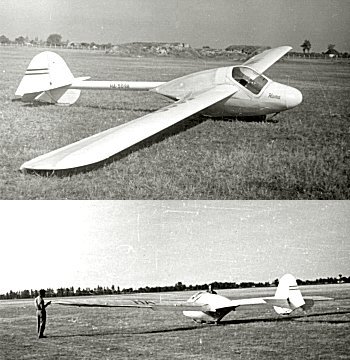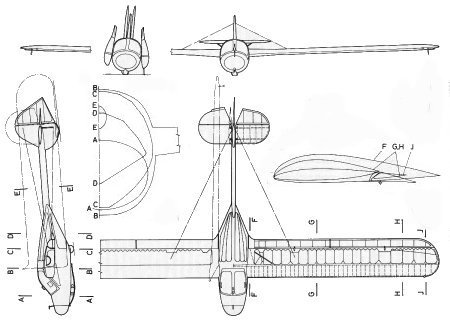HUNGARIAN
GLIDERS
1933-2000
| Type designation: |
R-15b |
| Name: |
Koma |
| Designer: |
Ernő RUBIK |
| Class: |
Dual training |
| General arrangement: |
Mid-wing, side-by-side seats, traditional tail unit |
| Crew: |
2 |
| First flight: |
April, 1949 |
| Manufacturer: |
Sportárutermelő Vállalat, Esztergom |
| Number of built: |
65 |

Short history:
The first sketches of a dual-control training glider with side-by-side seat arrangement (Koma) and a single-seater training glider (Lepke), the latter having the same handling characteristics as the two-seater, had been drawn up by Ernő Rubik as early as 1940. His idea was to develop a new training scheme based on gliders having the same handling characteristics and their construction would be easy and cheap due to similar parts and assemblies. However in the 1940s the financial interests of the Aero Ever Ltd., where his designs had been built, demanded to design and build the R-11b Cimbora two-seater school glider in series for the Hungarian Aero Association.
After the war, in 1948, an aircraft-design competition had been announced by the Hungarian National Aviation Association (OMRE), where the Koma design won in the two-seater and the Lepke design won in the single-seater category. At April, 1949, barely three month after the competition had been closed, the first R-15 Koma flew. After the test flights had been completed the prototype was evaluated by different flying schools. The side-by-side arrangement as well as the gliders' capability of high-winch launches were favourably valued by all instructors. However the rudder area was insufficient in aerotowing.
The glider had been redesigned by OMRE's design office in 1949-50, and the prototype of the new version got the designation of R-15a Koma. This prototype had no any kind of devices to help landing, and to land the fairly low-wing glider needed some skill because of ground effect. So the version, which finally was built in series, the R-15b Koma, featured a flap and the rudder was enlarged. The prototype of the R-15b Koma first flew at Jun, 1950. During 1950-51 65 R-15b Koma were built.
In the next decade the R-15b became the basic training glider of the new winch-launch-dual-instruction system in Hungary. The winch-hook was arranged near to the c.g. and the glider with flaps extended to take-off position were able to climb to 350 m in calm weather using 1000 m cable. The last Koma was withdrawn from service in the middle of the 1960s.
.jpg)
Structure: Mixed wooden-light metal
Wing:
The mid-wing glider's cantilever wing had a rectangular planform. The flaps were placed on the trailing edge between the wing-roots and the inner end of the ailerons. The settings of the flaps were 5 degrees for winch-launching and 60 degrees for landing. The wing had a wooden structure with one main spar and an additional diagonal steel-tube spar at the root. In the wing uniform rib-structures were used as the wing section was constant on nearly the whole span. The ribs of the ailerons, flaps, elevator and rudder were made of thin duraluminium sheets fastened to a single light-metal tube spar. The wing in front of the main spar was covered by plywood. All the other part of the wing as well as the ailerons and flaps were fabric covered.
The fittings of the wing connection were formed such a way that it was possible to fold the half wings alongside the fuselage, however beforehand the horizontal tail surfaces had to be folded up.
The R-15b Koma was safe of unintentional spinning. Even it was practically impossible to spin it intentionally due to the gradually increasing gaps between the wing and the leading edge of the ailerons.
Fuselage:
The fuselage consisted of two parts. The fore part was a closed, streamlined wooden structure the lower part of which was covered by plywood, the upper part by fabric. The aft part of the fuselage was a plywood covered wooden beam with small cross section. This beam was braced by two cables on both sides to the wing. The landing gear consisted of a fixed wheel located behind the c.g., a rubber dumped skid under the fore part of the fuselage, and a small skid under the vertical stabilizer. The wings were protected by curved steel-tube skids located under the wing tips.
The side-by-side seats were covered with a two-part streamlined plexiglas canopy. The two parts opened sideways in the direction of the centerline. The small instrument panel contained only a speedometer, an altimeter and a variometer.
Tail unit:
The tail unit had traditional arrangement. The ribs of the elevator and rudder were made of thin duraluminium sheets fastened to a single light-metal tube spar. The horizontal and vertical stabilizers were covered by plywood. The horizontal stabilizer were strutted and foldable.
The first prototype, R-15 Koma
.jpg)

| Dimensions: |
| Wing: |
| Span, m: |
14 (corrected) |
| Area, m2: |
18,04 |
| Aspect ratio: |
10,84 |
| Chord (root), m: |
1,3 |
| Chord (tip), m: |
1,0 |
| Airfoil (root), m: |
Gö 549 |
| Airfoil (mid-span), m: |
Gö 549 |
| Airfoil (tip), m: |
Gö 549 |
| Dihedral, degree: |
3 |
| Sweep, degree: |
0 |
| Washout: |
None |
| Aileron: |
| Span, m: |
3,6 |
| Mean chord, m: |
0,514 |
| Total area, m2: |
2,26 |
| Balancing: |
None |
| Flap: |
| Type: |
Plain |
| Area, m2: |
1,84 |
| Relative length, %: |
39,2 |
| Movement (up/down), degree: |
15/60 |
| Airbrakes: |
| Type: |
None |
| Horizontal stabilizer: |
| Span, m: |
2,44 |
| Area, m2: |
2,56 |
| Elevator: |
| Span, m: |
2,56 |
| Area, m2: |
1,1 |
| Airfoil: |
Special |
| Balancing: |
None |
| Trim: |
Yes |
| Vertical stabilizer and rudder: |
| Total area, m2: |
1,604 |
| Rudder area, m2: |
0,771 |
| Balancing: |
None |
| Fuselage: |
| Length, m: |
7,0 |
| Width, m: |
0,937 |
| Height: |
1,12 |
| Cross section, m2: |
0,78 |
| Landing gear: |
| Type: |
Fixed |
| Wheel diameter, m: |
0,26 |
| Masses: |
| Wing, kg: |
106 |
| Fuselage, kg: |
73 |
| Tail unit, kg: |
6 |
| Empty glider, kg: |
185 |
| Gross, kg: |
340 |
| Ballast, kg: |
None |
| Wing loading, kg/m2: |
18,85 |
| Speeds: |
| VNE, km/h: |
130 |
| Max. speed with flaps extended to 60 degrees, km/h: |
85 |
| Max. aerotow speed, km/h: |
80 |
| Max. winch speed, km/h: |
80 |
| Max. speed in rough air, km/h: |
80 |
| Stall speed, km/h: |
56 |
| Performance: |
| Min. sink, m/s (at gliding speed, km/h): |
1,05/63 |
| Best L/D (at gliding speed, km/h): |
17,4/70 |
| Start methods: |
Winch, Aerotow |

Origin of data and 3-view drawing:
Jereb Gábor: Magyar vitorlázó repülőgépek, Műszaki Könyvkiadó, 1988, Budapest
(Gábor JEREB: Hungarian Gliders, Technical Publishing House, 1988, Budapest)
Gábor FEKECS E-mail: fekecs.gabor@t-online.hu

.jpg)
.jpg)
